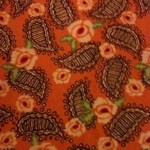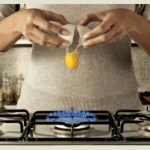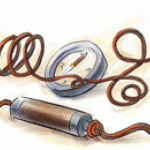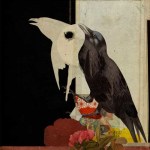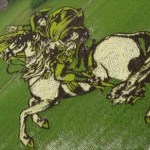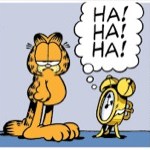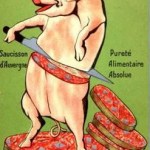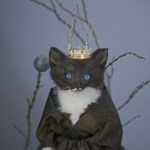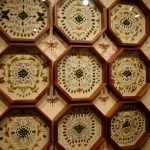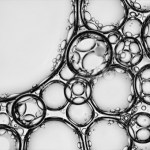ephemera
"Neurosigntist" and blogger John Ohab sent me this photo of garish carpet in a Vegas hotel. It appears to depict mitochondria on a field of roses. And it's really, really ugly. Thanks John!
Notice--Forest (McDonald's paper bag)
Paper Bag, Glue
Yuken Teruya, 2005
Paper artist Yuken Teruya does the impossible by turning a fast food bag into a stunning sunset-dappled lone tree. The Forest Series, creating paper trees out of disposable waste products like toilet paper tubes and paper bags, is a poignant glimpse of the forest behind the paper - it's a like a little bit of the lost trees' spirit lives on in the consumer end product. Yes - even McDonald's bags were once alive!
There's also something magical about looking from the inside of the bag outwards, sneaking behind the garish…
BIKES
cardboard and glue, life size
Chris Gilmore, 2003
I've been unpacking after the move, which means I'm surrounded by piles of cardboard boxes that need to be broken down and recycled. I wish I had Chris Gilmore's skill with cardboard! He sculpts machines and mechanisms, from Fiats to typewriters, entirely in quotidian corrugated cardboard and glue - materials we rarely think about and accord very little respect. Of course, these lightweight mimics don't actually function - but that makes a neat statement too, since so many of the everyday objects he sculpts are primarily functional, not…
Photographer: Rudy Huhold
Agency: Artplan
Apparently package delivery service Sedex Express is quite similar to. . . your brain on drugs. Hmmmm.
Via fubiz
It commemorates Hans Christian Ãrsted, who discovered the relationship between electricity and magenetism. Re-enact Ãrsted's experiment here.
But what about that other Hans Christian, Hans Christian Andersen? Here's what the Guardian had to say: "while there's nothing wrong with fairy stories, they haven't contributed much to the development of electric motors."
Ouch! :)
Artist Emmanuel Polanco does amazing collage work reminiscent of Eduardo Recife. I especially like this piece, but he has several more with more overt vintage-science content. See a gallery at Fubiz.
Japanese artist Kawano Takeshi's 2007 rendition of global warming is simple, a little funny, and a lot sad.
For another version of the same theme - using a real child's toy - check out Ours (the Bear), a video by French artist Simon Dronet. I'll try to embed it, but the link's wonky, so you might have to click through to see it.
OursUploaded by laperitel.
Via Fubiz
"O.K., let's slowly lower in the grant money."
Todd Bearson
Arlington, Mass.
This cartoon in the latest New Yorker gave me a (cynical) guffaw this morning. Nice caption, Todd Bearson. . . do you work in science? ;)
Reader Mike sent me the link to this Coke commercial a while ago. I love the exasperated brain pulling himself around - he's like a mob boss driven crazy by his stupid henchmen. Their other ads aren't quite as funny, because they make you overthink the situation (if the eyeball can't drink Coke because it has no mouth, how is it talking?)
Alstroemeria, sp.
Robert Buelteman
One of my favorite short stories is Hawthorne's Rappaccini's Daughter, in which an eccentric, Frankensteinian botanist breeds increasingly beautiful, increasingly deadly flowers. These images from Robert Buelteman remind me of Rappaccini's garden. His creative process sure sounds like something Dr. Frankenstein might have employed:
Buelteman hits everything with an electric pulse and the electrons do a dance as they leap from the sheet metal, through the silicone and the plant (and hopefully not through him), while heading back out the jumper cables. In…
Check out these remarkable photos of patterns grown in Japanese rice fields using different strains of pigmented rice. A number of commenters on the thread at funster have suggested the photos are faked, so I found this Japanese news clip on YouTube. I like the art in the video clip even better! :)
I've posted before that I'm a big fan of Garfield Minus Garfield, the alternate reality in which Jon Arbuckle's barely suppressed mental illness is fully revealed. Now we have Garfield: Lost In Translation, in which the dialogue is translated into Japanese and back into English.
Though not as awesome as Garfield Minus Garfield, I still laughed harder at that strip than any of the original Garfields. More here.
Earlier, I blogged about the seriously flawed Telegraph article about rape. Now Carl Zimmer has discovered that the newspaper has yanked the article from its site. No explanation, no apology - it's just gone.
I feel silly that I didn't grab a screencapture of the original article. Although I'm aware that nothing is immutable on the Internet, it just didn't occur to me that someone would yank a published article from a newspaper with no explanation. I guess we have to think of online newspapers as unreliable AND impermanent. Ephemeral, in fact - just like the real, pulpy, newsprint-smudgy…
If anything can put you off bacon, this awesome vintage French ad will!
While the ad appears bizarre to us today, it makes sense in a different social context - one in which animals exist primarily to serve human needs, and all's right with the world when they're fulfilling that function.
I find it especially interesting to consider the parallel between this ad - a happy pig slicing itself up for consumption - and the tradition of human anatomical models holding their own innards open for examination. Bizarre and disturbing, yes - but mainly because we're looking at them with modern eyes.…
nmohan of the collaborative artists group Robot Disorder just contacted me to let me know they've launched the Robot Disorder 2.0 website, with more robot hordes (and easier navigation). He says they have literally thousands of robot drawings to clean up and post in the coming weeks, so if you haven't yet seen your personal robot, never fear - it's on its way.
And it's not too late to contribute your own robot to the project - just visit the top floor at Artomatic in Washington DC before July 5!
Joanna of Morbid Anatomy is on a quest to locate private collections of medical oddities. She's already sussed out fourteen such hidden wunderkammern and photographed their treasures, but she wants to find more:
"Who are these private collectors, and what sort of treasures do they possess? How might their methods of displaying collections differ from institutional approaches? Are we reaching a historical moment similar to the pre-museum era of private cabinets, in which the most interesting artifacts are now in private rather than public hands?"
It's a really interesting question.…
Curious Expeditions has a great interview with Jennifer Angus, the artist who recently redecorated the Newark Museum's Victorian Ballentine House with dead insects in an installation called "Insecta Fantasia." Wow!
The Museum restored the elegant abode to its original dark wood and horror vaccui (fear of empty space) style. This fear of empty space is often seen in Victorian homes - pictures covering every inch of wall, furniture and carpets covering all available floor space, murals and moulding on the ceilings, objects crowding every surface, elaborate window coverings and stained glass in…
I blogged previously about Jan Vormann, who went around medieval villages near Rome patching holes with Lego. Now Vormann has moved on to Berlin, where he's filling World War II bullet holes with multicolored patches. That's just awesome, on many levels. More photos here.
Vormann is represented by the gallery Jarmuschek + Partner. Via today and tomorrow.
Sometimes art doesn't need to be complicated. Shawn Knol's simple videos of oil in water capture fascinating patterns reminiscent of dividing cells, budding spores or lava lamps, depending on your mood. His newest, Psycho Bubble (above), was just released a few days ago.
"A lot of people are asking how I did this. It's pretty simple. I just put the camera on its lowest jpeg setting, placed the camera into continuous mode, and locked the shutter down with my wired remote. The oil is being dumped into a tall cylindrical glass, with about a cup of water in it. The whole thing is lit from…
While I was out of town this weekend, one of my friends lost her dog. As I read over the many caring comments on her Facebook page, it struck me how difficult it is to express condolences - especially on the loss of a pet. Like many others, I ended up simply saying "I'm sorry."
The significance of the relationship between pet and person is often minimized, even though we know that the unconditional love supplied by a pet can do astonishing things for human mental and physical health. Personally, I don't believe animals have souls, but neither do I believe they are soulless automatons. Cats…
